Abstract
1. The objective of this study was to evaluate the effects of three sulphydryl (SH) compounds, N-acetylcysteine (NAC), cysteine (Cys) and cystamine, on functional recovery and ventricular arrhythmias (VF) in stunned myocardium in the isolated perfused heart of the rat. 2. Hearts (n = 7-8 per group) were perfused by the Langendorff procedure for 20 min to stabilize and then assigned to one of five groups: saline, sham, NAC, Cys and cystamine. After the stabilizing period, the drugs (at 3.6 microM min-1) or their vehicle (saline) were infused into coronary vessels throughout the experimental period. Ten min after administration of drugs, the left anterior descending coronary artery (LAD) was ligatured for 20 min and then untied to reperfuse for 30 min. In the sham group, a ligature was placed around the LAD but not tied. 3. NAC and Cys had a significant effect in attenuating myocardial stunning: the percentage recovery of rate-pressure product measured 30 min after reperfusion as an index of heart function, was improved with the NAC (98.3 +/- 4.5) and Cys groups (104.0 +/- 6.5) compared with the saline (only 73.6 +/- 3.8, P < 0.01) group. Cystamine did not show these beneficial effects. This may be due to the difference in chemical structure between NAC, Cys and cystamine since the latter does not have a free SH group with a disulphide bond formed. This phenomenon suggests that a free SH group is essential for the protective effects of compounds like NAC and Cys in myocardial injury.(ABSTRACT TRUNCATED AT 250 WORDS)
Full text
PDF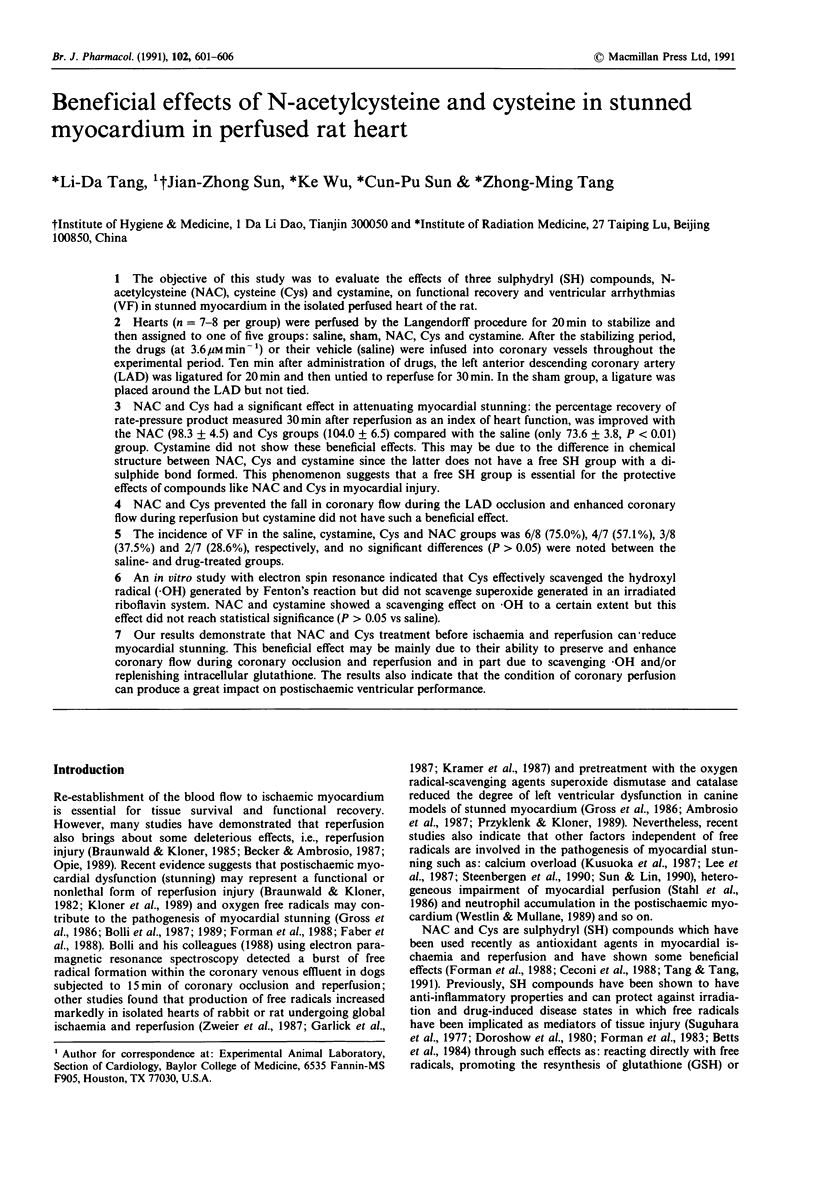
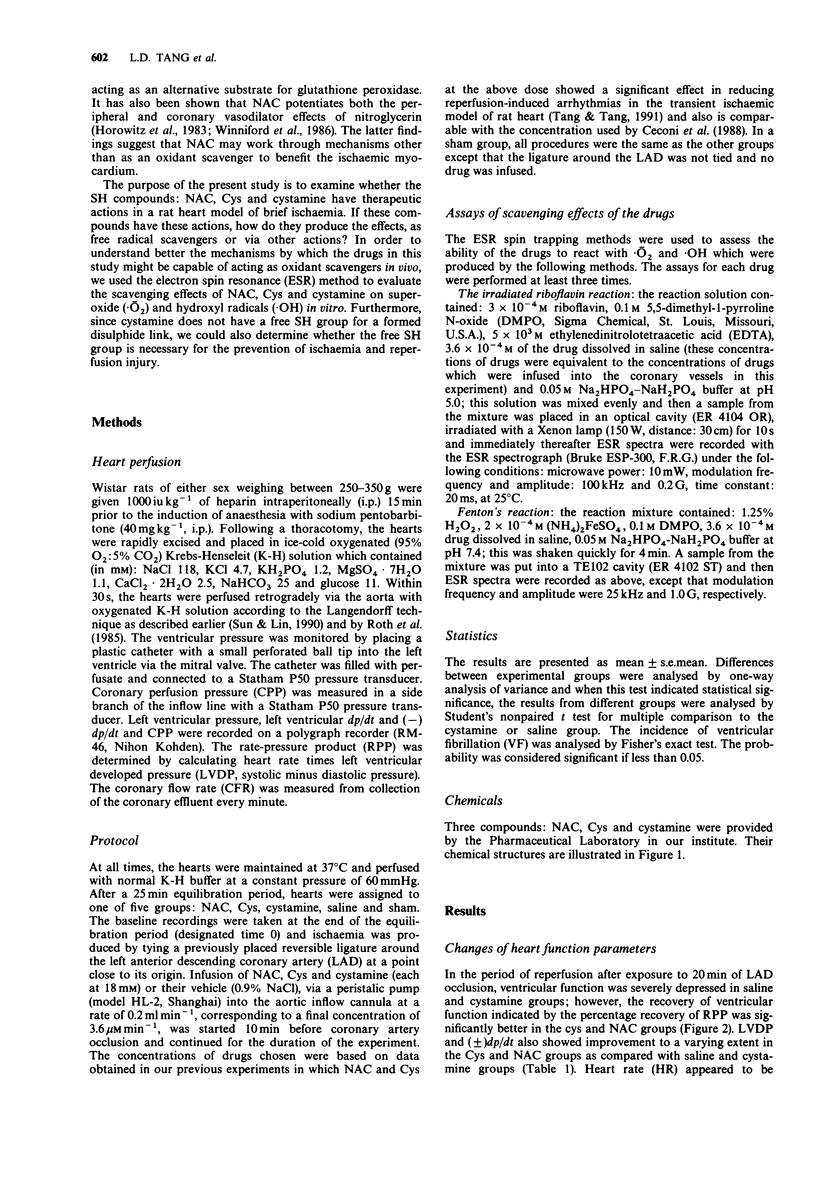
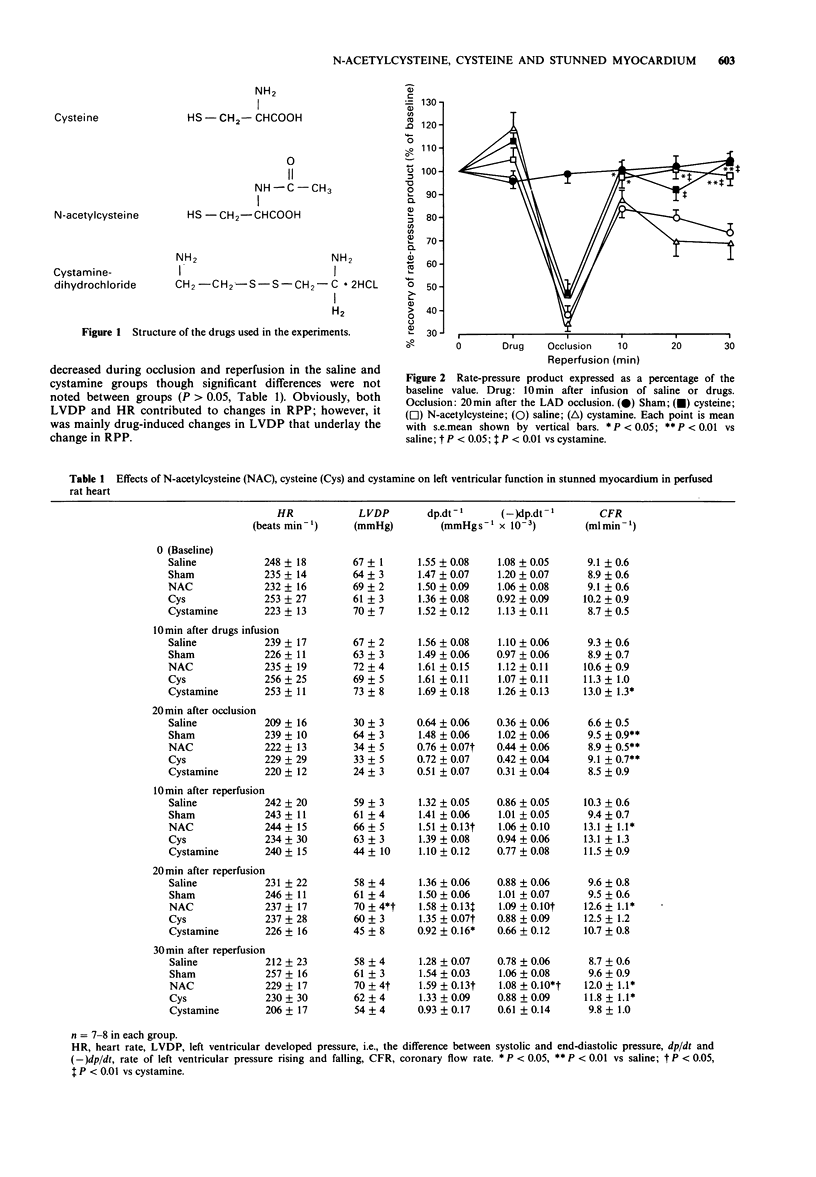
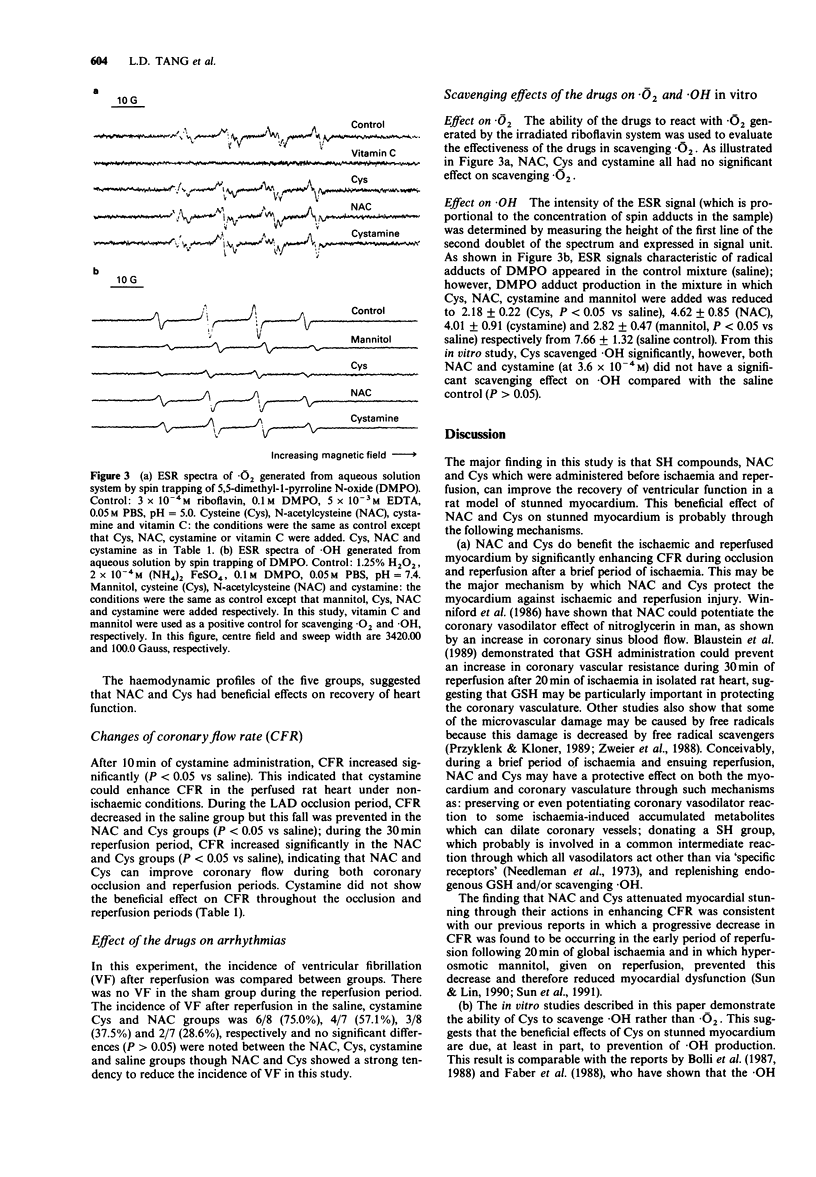
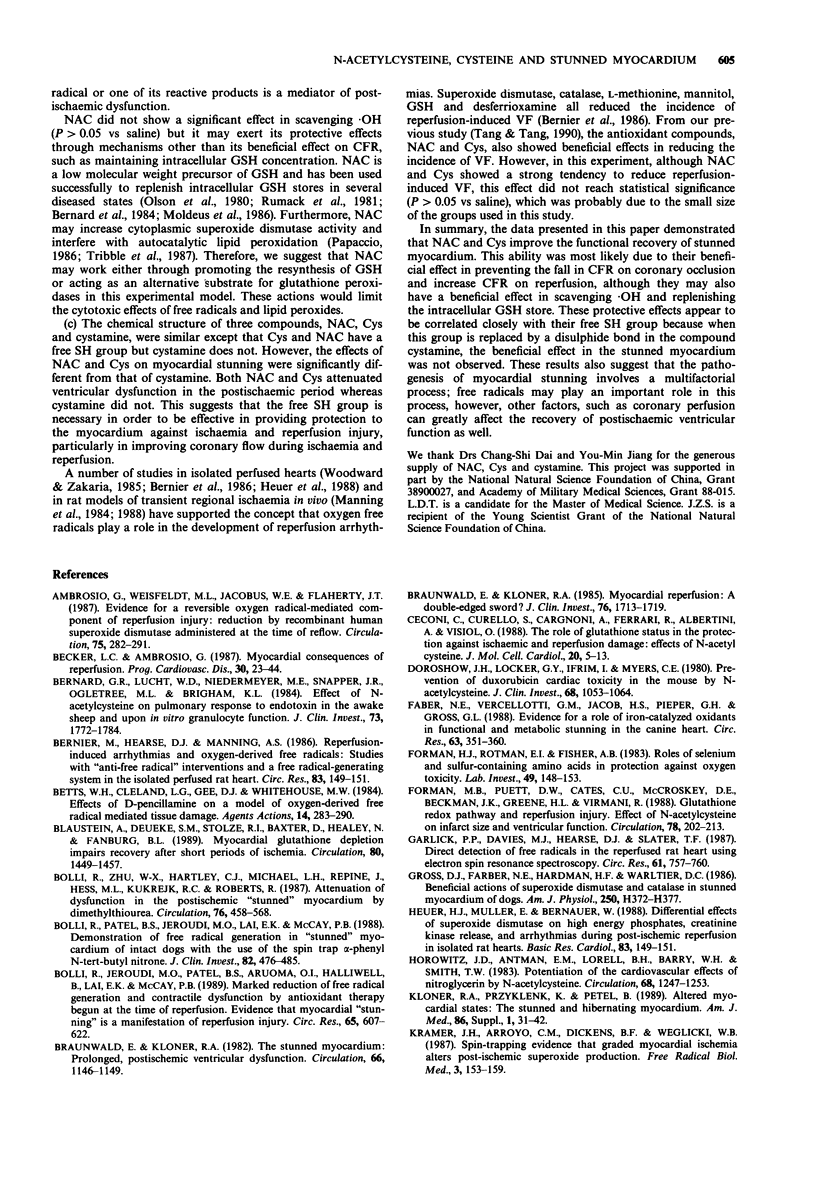
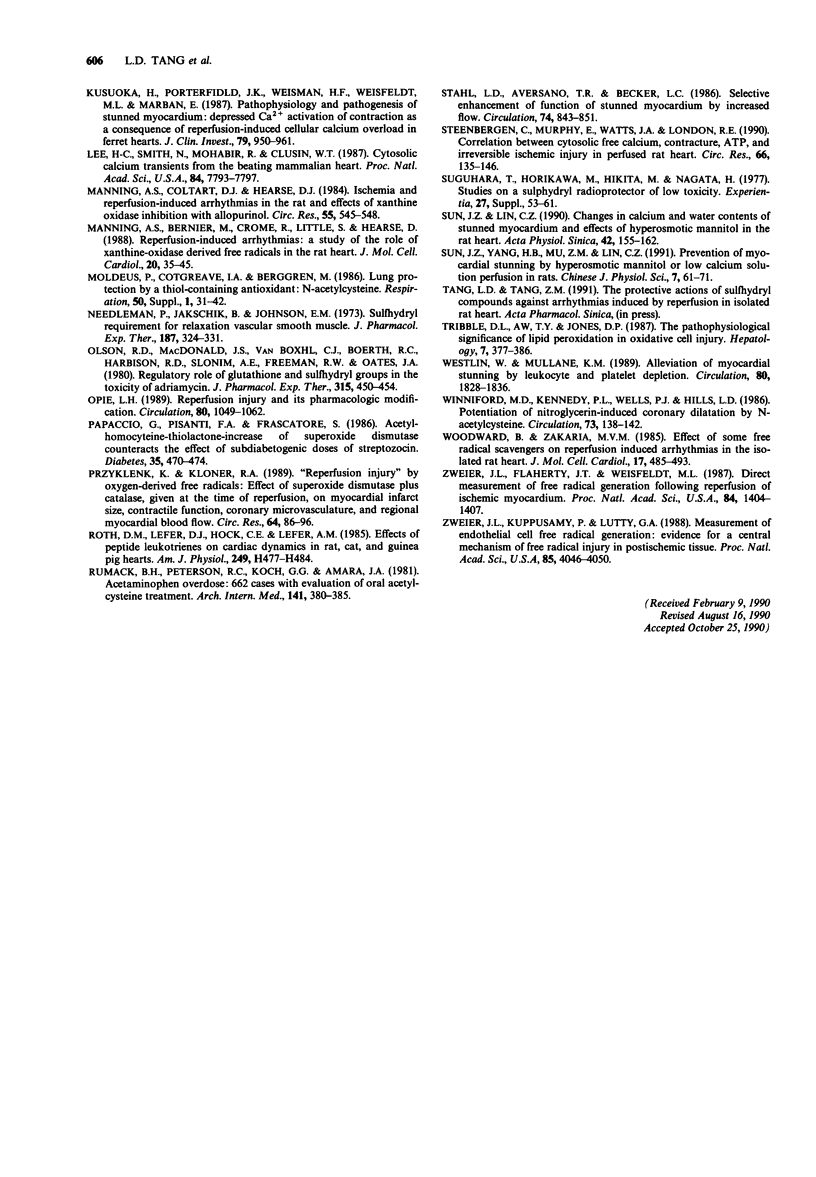
Selected References
These references are in PubMed. This may not be the complete list of references from this article.
- Ambrosio G., Weisfeldt M. L., Jacobus W. E., Flaherty J. T. Evidence for a reversible oxygen radical-mediated component of reperfusion injury: reduction by recombinant human superoxide dismutase administered at the time of reflow. Circulation. 1987 Jan;75(1):282–291. doi: 10.1161/01.cir.75.1.282. [DOI] [PubMed] [Google Scholar]
- Becker L. C., Ambrosio G. Myocardial consequences of reperfusion. Prog Cardiovasc Dis. 1987 Jul-Aug;30(1):23–44. doi: 10.1016/0033-0620(87)90009-0. [DOI] [PubMed] [Google Scholar]
- Bernard G. R., Lucht W. D., Niedermeyer M. E., Snapper J. R., Ogletree M. L., Brigham K. L. Effect of N-acetylcysteine on the pulmonary response to endotoxin in the awake sheep and upon in vitro granulocyte function. J Clin Invest. 1984 Jun;73(6):1772–1784. doi: 10.1172/JCI111386. [DOI] [PMC free article] [PubMed] [Google Scholar]
- Betts W. H., Cleland L. G., Gee D. J., Whitehouse M. W. Effects of D-penicillamine on a model of oxygen-derived free radical mediated tissue damage. Agents Actions. 1984 Feb;14(2):283–290. doi: 10.1007/BF01966654. [DOI] [PubMed] [Google Scholar]
- Blaustein A., Deneke S. M., Stolz R. I., Baxter D., Healey N., Fanburg B. L. Myocardial glutathione depletion impairs recovery after short periods of ischemia. Circulation. 1989 Nov;80(5):1449–1457. doi: 10.1161/01.cir.80.5.1449. [DOI] [PubMed] [Google Scholar]
- Bolli R., Jeroudi M. O., Patel B. S., Aruoma O. I., Halliwell B., Lai E. K., McCay P. B. Marked reduction of free radical generation and contractile dysfunction by antioxidant therapy begun at the time of reperfusion. Evidence that myocardial "stunning" is a manifestation of reperfusion injury. Circ Res. 1989 Sep;65(3):607–622. doi: 10.1161/01.res.65.3.607. [DOI] [PubMed] [Google Scholar]
- Bolli R., Patel B. S., Jeroudi M. O., Lai E. K., McCay P. B. Demonstration of free radical generation in "stunned" myocardium of intact dogs with the use of the spin trap alpha-phenyl N-tert-butyl nitrone. J Clin Invest. 1988 Aug;82(2):476–485. doi: 10.1172/JCI113621. [DOI] [PMC free article] [PubMed] [Google Scholar]
- Bolli R., Zhu W. X., Hartley C. J., Michael L. H., Repine J. E., Hess M. L., Kukreja R. C., Roberts R. Attenuation of dysfunction in the postischemic 'stunned' myocardium by dimethylthiourea. Circulation. 1987 Aug;76(2):458–468. doi: 10.1161/01.cir.76.2.458. [DOI] [PubMed] [Google Scholar]
- Braunwald E., Kloner R. A. Myocardial reperfusion: a double-edged sword? J Clin Invest. 1985 Nov;76(5):1713–1719. doi: 10.1172/JCI112160. [DOI] [PMC free article] [PubMed] [Google Scholar]
- Braunwald E., Kloner R. A. The stunned myocardium: prolonged, postischemic ventricular dysfunction. Circulation. 1982 Dec;66(6):1146–1149. doi: 10.1161/01.cir.66.6.1146. [DOI] [PubMed] [Google Scholar]
- Ceconi C., Curello S., Cargnoni A., Ferrari R., Albertini A., Visioli O. The role of glutathione status in the protection against ischaemic and reperfusion damage: effects of N-acetyl cysteine. J Mol Cell Cardiol. 1988 Jan;20(1):5–13. doi: 10.1016/s0022-2828(88)80174-3. [DOI] [PubMed] [Google Scholar]
- Doroshow J. H., Locker G. Y., Ifrim I., Myers C. E. Prevention of doxorubicin cardiac toxicity in the mouse by N-acetylcysteine. J Clin Invest. 1981 Oct;68(4):1053–1064. doi: 10.1172/JCI110328. [DOI] [PMC free article] [PubMed] [Google Scholar]
- Farber N. E., Vercellotti G. M., Jacob H. S., Pieper G. M., Gross G. J. Evidence for a role of iron-catalyzed oxidants in functional and metabolic stunning in the canine heart. Circ Res. 1988 Aug;63(2):351–360. doi: 10.1161/01.res.63.2.351. [DOI] [PubMed] [Google Scholar]
- Forman H. J., Rotman E. I., Fisher A. B. Roles of selenium and sulfur-containing amino acids in protection against oxygen toxicity. Lab Invest. 1983 Aug;49(2):148–153. [PubMed] [Google Scholar]
- Forman M. B., Puett D. W., Cates C. U., McCroskey D. E., Beckman J. K., Greene H. L., Virmani R. Glutathione redox pathway and reperfusion injury. Effect of N-acetylcysteine on infarct size and ventricular function. Circulation. 1988 Jul;78(1):202–213. doi: 10.1161/01.cir.78.1.202. [DOI] [PubMed] [Google Scholar]
- Garlick P. B., Davies M. J., Hearse D. J., Slater T. F. Direct detection of free radicals in the reperfused rat heart using electron spin resonance spectroscopy. Circ Res. 1987 Nov;61(5):757–760. doi: 10.1161/01.res.61.5.757. [DOI] [PubMed] [Google Scholar]
- Gross G. J., Farber N. E., Hardman H. F., Warltier D. C. Beneficial actions of superoxide dismutase and catalase in stunned myocardium of dogs. Am J Physiol. 1986 Mar;250(3 Pt 2):H372–H377. doi: 10.1152/ajpheart.1986.250.3.H372. [DOI] [PubMed] [Google Scholar]
- Heuer H. J., Müller E., Bernauer W. Differential effects of superoxide dismutase on high energy phosphates, creatine kinase release, and arrhythmias during post-ischaemic reperfusion in isolated rat hearts. Basic Res Cardiol. 1988 Mar-Apr;83(2):149–157. doi: 10.1007/BF01907269. [DOI] [PubMed] [Google Scholar]
- Horowitz J. D., Antman E. M., Lorell B. H., Barry W. H., Smith T. W. Potentiation of the cardiovascular effects of nitroglycerin by N-acetylcysteine. Circulation. 1983 Dec;68(6):1247–1253. doi: 10.1161/01.cir.68.6.1247. [DOI] [PubMed] [Google Scholar]
- Kramer J. H., Arroyo C. M., Dickens B. F., Weglicki W. B. Spin-trapping evidence that graded myocardial ischemia alters post-ischemic superoxide production. Free Radic Biol Med. 1987;3(2):153–159. doi: 10.1016/s0891-5849(87)80011-4. [DOI] [PubMed] [Google Scholar]
- Kusuoka H., Porterfield J. K., Weisman H. F., Weisfeldt M. L., Marban E. Pathophysiology and pathogenesis of stunned myocardium. Depressed Ca2+ activation of contraction as a consequence of reperfusion-induced cellular calcium overload in ferret hearts. J Clin Invest. 1987 Mar;79(3):950–961. doi: 10.1172/JCI112906. [DOI] [PMC free article] [PubMed] [Google Scholar]
- Lee H. C., Smith N., Mohabir R., Clusin W. T. Cytosolic calcium transients from the beating mammalian heart. Proc Natl Acad Sci U S A. 1987 Nov;84(21):7793–7797. doi: 10.1073/pnas.84.21.7793. [DOI] [PMC free article] [PubMed] [Google Scholar]
- Manning A. S., Coltart D. J., Hearse D. J. Ischemia and reperfusion-induced arrhythmias in the rat. Effects of xanthine oxidase inhibition with allopurinol. Circ Res. 1984 Oct;55(4):545–548. doi: 10.1161/01.res.55.4.545. [DOI] [PubMed] [Google Scholar]
- Manning A., Bernier M., Crome R., Little S., Hearse D. Reperfusion-induced arrhythmias: a study of the role of xanthine oxidase-derived free radicals in the rat heart. J Mol Cell Cardiol. 1988 Jan;20(1):35–45. doi: 10.1016/s0022-2828(88)80177-9. [DOI] [PubMed] [Google Scholar]
- Moldéus P., Cotgreave I. A., Berggren M. Lung protection by a thiol-containing antioxidant: N-acetylcysteine. Respiration. 1986;50 (Suppl 1):31–42. doi: 10.1159/000195086. [DOI] [PubMed] [Google Scholar]
- Needleman P., Jakschik B., Johnson E. M., Jr Sulfhydryl requirement for relaxation of vascular smooth muscle. J Pharmacol Exp Ther. 1973 Nov;187(2):324–331. [PubMed] [Google Scholar]
- Olson R. D., MacDonald J. S., vanBoxtel C. J., Boerth R. C., Harbison R. D., Slonim A. E., Freeman R. W., Oates J. A. Regulatory role of glutathione and soluble sulfhydryl groups in the toxicity of adriamycin. J Pharmacol Exp Ther. 1980 Nov;215(2):450–454. [PubMed] [Google Scholar]
- Opie L. H. Reperfusion injury and its pharmacologic modification. Circulation. 1989 Oct;80(4):1049–1062. doi: 10.1161/01.cir.80.4.1049. [DOI] [PubMed] [Google Scholar]
- Papaccio G., Pisanti F. A., Frascatore S. Acetyl-homocysteine-thiolactone-induced increase of superoxide dismutase counteracts the effect of subdiabetogenic doses of streptozocin. Diabetes. 1986 Apr;35(4):470–474. doi: 10.2337/diab.35.4.470. [DOI] [PubMed] [Google Scholar]
- Przyklenk K., Kloner R. A. "Reperfusion injury" by oxygen-derived free radicals? Effect of superoxide dismutase plus catalase, given at the time of reperfusion, on myocardial infarct size, contractile function, coronary microvasculature, and regional myocardial blood flow. Circ Res. 1989 Jan;64(1):86–96. doi: 10.1161/01.res.64.1.86. [DOI] [PubMed] [Google Scholar]
- Roth D. M., Lefer D. J., Hock C. E., Lefer A. M. Effects of peptide leukotrienes on cardiac dynamics in rat, cat, and guinea pig hearts. Am J Physiol. 1985 Sep;249(3 Pt 2):H477–H484. doi: 10.1152/ajpheart.1985.249.3.H477. [DOI] [PubMed] [Google Scholar]
- Rumack B. H., Peterson R. C., Koch G. G., Amara I. A. Acetaminophen overdose. 662 cases with evaluation of oral acetylcysteine treatment. Arch Intern Med. 1981 Feb 23;141(3 Spec No):380–385. doi: 10.1001/archinte.141.3.380. [DOI] [PubMed] [Google Scholar]
- Stahl L. D., Aversano T. R., Becker L. C. Selective enhancement of function of stunned myocardium by increased flow. Circulation. 1986 Oct;74(4):843–851. doi: 10.1161/01.cir.74.4.843. [DOI] [PubMed] [Google Scholar]
- Steenbergen C., Murphy E., Watts J. A., London R. E. Correlation between cytosolic free calcium, contracture, ATP, and irreversible ischemic injury in perfused rat heart. Circ Res. 1990 Jan;66(1):135–146. doi: 10.1161/01.res.66.1.135. [DOI] [PubMed] [Google Scholar]
- Sugahara T., Horikawa M., Hikita M., Nagata H. Studies on a sulfhydryl radioprotector of low toxicity. Experientia Suppl. 1977;27:53–61. doi: 10.1007/978-3-0348-5582-2_5. [DOI] [PubMed] [Google Scholar]
- Sun J. Z., Lin C. Z. [Changes in calcium and water content of stunned myocardium and effects of hyperosmotic mannitol in rat heart]. Sheng Li Xue Bao. 1990 Apr;42(2):155–162. [PubMed] [Google Scholar]
- Tribble D. L., Aw T. Y., Jones D. P. The pathophysiological significance of lipid peroxidation in oxidative cell injury. Hepatology. 1987 Mar-Apr;7(2):377–386. doi: 10.1002/hep.1840070227. [DOI] [PubMed] [Google Scholar]
- Westlin W., Mullane K. M. Alleviation of myocardial stunning by leukocyte and platelet depletion. Circulation. 1989 Dec;80(6):1828–1836. doi: 10.1161/01.cir.80.6.1828. [DOI] [PubMed] [Google Scholar]
- Winniford M. D., Kennedy P. L., Wells P. J., Hillis L. D. Potentiation of nitroglycerin-induced coronary dilatation by N-acetylcysteine. Circulation. 1986 Jan;73(1):138–142. doi: 10.1161/01.cir.73.1.138. [DOI] [PubMed] [Google Scholar]
- Woodward B., Zakaria M. N. Effect of some free radical scavengers on reperfusion induced arrhythmias in the isolated rat heart. J Mol Cell Cardiol. 1985 May;17(5):485–493. doi: 10.1016/s0022-2828(85)80053-5. [DOI] [PubMed] [Google Scholar]
- Zweier J. L., Flaherty J. T., Weisfeldt M. L. Direct measurement of free radical generation following reperfusion of ischemic myocardium. Proc Natl Acad Sci U S A. 1987 Mar;84(5):1404–1407. doi: 10.1073/pnas.84.5.1404. [DOI] [PMC free article] [PubMed] [Google Scholar]
- Zweier J. L., Kuppusamy P., Lutty G. A. Measurement of endothelial cell free radical generation: evidence for a central mechanism of free radical injury in postischemic tissues. Proc Natl Acad Sci U S A. 1988 Jun;85(11):4046–4050. doi: 10.1073/pnas.85.11.4046. [DOI] [PMC free article] [PubMed] [Google Scholar]


